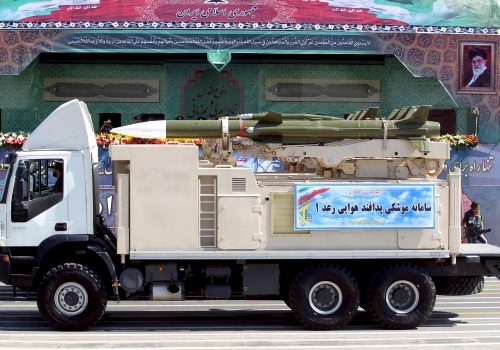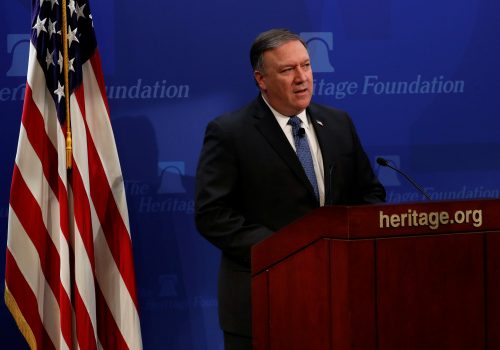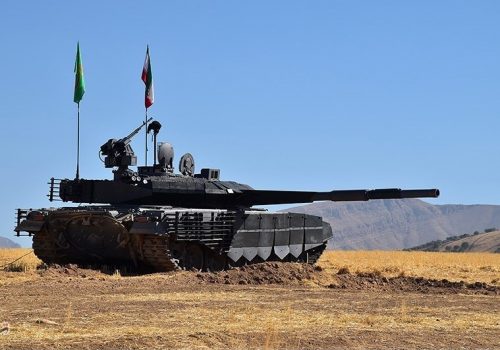What Iran might sell now that the UN arms embargo expired
The October 18 expiration of a decade-long United Nations (UN) arms embargo on Iran has raised considerable speculation on what weapons the Islamic Republic will buy. However, the end of the embargo means that Iran can not only import military hardware but can also return to the market as an exporter.
President Hassan Rouhani has openly said that Iran expects to sell more arms than it procures. The statement was not surprising given Iran’s need to boost non-oil exports as well as Iran’s past expressions of readiness to export military hardware to its allies “in order to prevent wars.” Already in 2017, the Iranian defense industry participated in the IQDEX Defense, Security, and Aviation Exhibition in Baghdad. The Iranian stand was the second largest after China’s.
Iran’s track record as an arms seller is relatively limited compared to other countries in the region, such as Israel, Turkey, and the United Arab Emirates. Iran’s main customer has been Iraq, which procured about $10 million in Iranian weapons just in 2014. They reportedly included communication systems, short-range multiple rocket launchers (the Type 63/Fajr-1 107-mm system), anti-tank missiles, recoilless rifles (copies of the M40 106-mm rifles), and sniper rifles (such as the Sayyad rifles produced in Iran without a license—a copy of the Austrian Steyr HS .50 BMG anti-materiel rifles). Iran also delivered vehicles, likes the locally produced Safir 4×4 multipurpose light vehicles used by Kataib Hezbollah, an Iran-backed Shia militia in Iraq.
Some Iranian weapons have been sold or donated to Syria. They reportedly include the Bavar-373 and Khordad-3 air defense systems. According to some sources, Iranian ammunition has been found in at least nine African countries. Iran has sold Rakhsh (4×4) armored personal carriers, Boragh vehicles, and an unspecified number of Ababil-3 and Mohajer UAVs manufactured by Ghods Aviation Industries to Sudan. Other weapons transferred to the region include light arms, such as G-3 rifles, rocket-propelled grenade (RPG) launchers, mortars (60-mm and 82-mm), rocket artillery, and landmines.
Light arms and ammunition have also been delivered to Shia militias in Iraq and Syria, as well as to Lebanese militant group Hezbollah. Yemen’s Houthi rebels were supplied—most likely by Iran—with Qasef-1 suicide drones and light arms. However, such transfers are primarily a function of Iran’s regional strategy of supporting proxies rather than a traditional state-to-state arms import/export procedure.
The full extent of what Iran can export remains somewhat unclear. Iranian defense companies do not attend major international defense exhibitions like Eurosatory and IDEX. They also do not invite foreign journalists to see their products and facilities. Thus, all analyses, including this one, are based mainly on assumptions rather than verifiable evidence and hard data. However, it is highly likely that the Iranian defense industry could offer additional items, such as personal gear, Safir tactical military weapons, ammunition of various calibers, light arms, including mortars, the Shaher 14.5-mm anti-materiel sniper rifle, and machineguns, like a modified 12.7×108-mm DshK, for export.
Many of those arms have been shown in Iran at the Police, Safety, and Security Exhibition (IPAS), which is held annually in Tehran.
Blocked from buying most advanced arms for decades, Iran prides itself on its ability to reverse-engineer old systems and improve on them.
Other potential export products—which Iran is likely to manufacture indigenously—include some anti-tank systems, both guided missiles (ATGMs) and RPGs. In the past, Hezbollah was equipped by Iran with the BGM-71/Toophan and 9M113 Kornet/Dehlavie anti-tank guided missiles. Iran might be also able to offer the RPG-29, which has been used in Iraq and in Lebanon against Israeli missiles, or the Misagh system, which is a local version of the Chinese QW-1 man-portable air-defense system (MANPAD). The latter has been transferred to Shia militias in Iraq and most likely to militias in Syria. The list could also include various unguided rocket systems, such as the Fajr, which has already been seen in various locations in the Middle East.
Iran could also sell its highly capable unmanned aerial vehicles (UAVs) and so-called loitering munitions (kamikaze drones), the usefulness of which was recently confirmed during new fighting in the disputed territory of Nagorno-Karabakh. According to the Iranian press, Russia has already expressed its intention to buy Iranian drones, although it is likely that the Kremlin would try to acquire a license to produce them locally. If Iran’s boasts about its production capabilities and technological advancements are valid, then it could also offer its radars, as well as ballistic and cruise missiles. However, export of those technologies could pose a risk to Iran if such systems were later indirectly acquired by either the United States or Israel, since it would enable Iran’s enemies to more effectively counter them. Moreover, an export of UAVs would not make Iran rich—these are relatively cheap systems. For instance, Ukraine recently bought twelve Turkish combat UAVs for $73 million.
The Iranian defense industry could also offer services, such as maintenance and modernization packages. Due to low labor costs in Iran, these offers could be attractive to less wealthy customers, including some African countries. Iranian engineers have demonstrated impressive skills in keeping aging platforms operational. In the past, Iran was involved in some helicopter overhauls in Zimbabwe and planned to open a center for maintenance, repair, and overhaul of helicopters in that country. Those plans fell through, but Tehran might now seek to re-launch that initiative somewhere else in Africa, taking advantage of the expiration of UN sanctions.
Robert Czulda is an assistant professor at the University of Lodz, Poland and a former visiting professor at Islamic Azad University in Iran, the University of Maryland and National Cheng-chi University in Taiwan. He is the author of Iran 1925 – 2014: From Reza Shah to Rouhani. Follow him on Twitter: @RobertCzulda.
Subscribe for more from IranSource
Sign up for the IranSource newsletter, which provides a holistic look at Iran’s internal dynamics, global and regional policies, and posture through unique analysis of current events and long-term, strategic issues related to Iran.
Image: An Iranian locally made cruise missile is fired during war games in the northern Indian Ocean and near the entrance to the Gulf, Iran June 17, 2020. Picture taken June 17, 2020. WANA (West Asia News Agency) via REUTERS.


